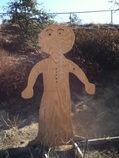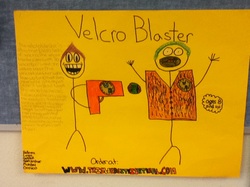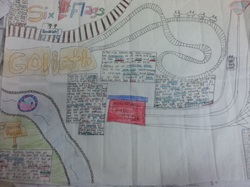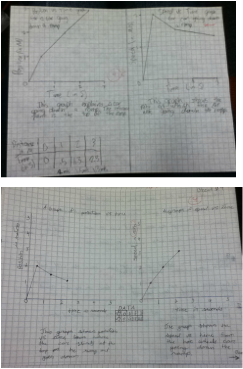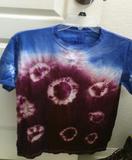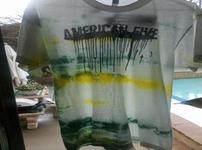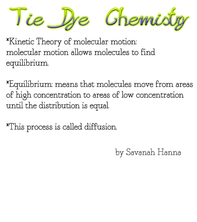Physical Science Projects - The Main Yard
|
|
|
| ||||||||||||||||||||||||||||||||||||||||||||||||
The Density Column Project
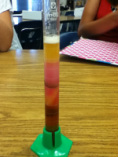
For this lab you had to be able to calculate the density of both solids and liquids. The highest scoring projects were able to find and layer seven different substances as well as have two solids that would float at two different levels within those liquids. Tough stuff! ...but my kids can do it!
|
|
Kids working on their density columns.
| ||||||
Planetary Explorer Project
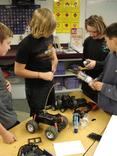
Man is becoming increasingly complex in how he/she investigates our universe and it seems like robotic explorers are on the forefront of this exploration. The days of the static landers (Viking) are over, and the days of truly durable, and somewhat intelligent, robots are here. The Mars rovers (Spirit and Opportunity) had to not only land safely, but also to navigate rugged terrain. Those rovers were "kicking" years longer than anyone ever expected. The lander that set down on Titan (Cassini), one of Saturn's moons, had to be able to float in the event it touched down in pools of ethane. Who knows what the next generation of planetary explorers will bring!
Here’s what your students had to do to make their planetary explorer... Students work in teams of up to four people. These team mates may construct their Planetary Explorer from any materials found around the home, with a few guidelines…
Rule #1: No explorer may be under 100g
Rule #2: The explorer must be constructed from materials that were not originally used for the purpose they fulfill on the vehicle. The only exception to this rule is for wheels, axles, motors, and frames. All other attachments and body work must be original in their design.
This vehicle, once built, will have to run an obstacle course (point value=cm/s), climb hills (point value=degrees x 10), push mass(point value=mass/3), fight other cars(point value =100 per win), and can optionally compete in the float and drop bonus events (point value= +200 per). The points scored n each of these events will be divided by the total mass of the car. This Overall Performance Ratio (OPR) will determine the winners! This means that you better find a good balance between performance and mass! An OPR of under 1.2 pts/g is a 3, an OPR between 1.2 and 1.49 is a 4, and an OPR of 1.5 or over is a 5.
PARENTS: This project is meant to low, or no, cost! $6 RC cars fare FAR better than $100 or $300 cars. This is not about being the fastest, it's about engineering and efficiency.
The Current World Records:
The Crater Climb Event: It was set in 2006 by team “Border Patrol” and tied in 2008 by team "Cheezit Munchers" is 54 degrees!
The Speed Event: This was set in 2008 by team “Tango” is 426.6 cm/s
The Push Event: This record was set in 2009 by team “World Domination” and they pushed 4318g
Because of the nature of the Fight Event the number of fights can vary from class to class. Champions in the fighting event typically score around 5-7 wins.
The Highest OPR scored came in 2009 by team "Tiny but Mighty" and was caluculated at 8.275pts/g
Here’s what your students had to do to make their planetary explorer... Students work in teams of up to four people. These team mates may construct their Planetary Explorer from any materials found around the home, with a few guidelines…
Rule #1: No explorer may be under 100g
Rule #2: The explorer must be constructed from materials that were not originally used for the purpose they fulfill on the vehicle. The only exception to this rule is for wheels, axles, motors, and frames. All other attachments and body work must be original in their design.
This vehicle, once built, will have to run an obstacle course (point value=cm/s), climb hills (point value=degrees x 10), push mass(point value=mass/3), fight other cars(point value =100 per win), and can optionally compete in the float and drop bonus events (point value= +200 per). The points scored n each of these events will be divided by the total mass of the car. This Overall Performance Ratio (OPR) will determine the winners! This means that you better find a good balance between performance and mass! An OPR of under 1.2 pts/g is a 3, an OPR between 1.2 and 1.49 is a 4, and an OPR of 1.5 or over is a 5.
PARENTS: This project is meant to low, or no, cost! $6 RC cars fare FAR better than $100 or $300 cars. This is not about being the fastest, it's about engineering and efficiency.
The Current World Records:
The Crater Climb Event: It was set in 2006 by team “Border Patrol” and tied in 2008 by team "Cheezit Munchers" is 54 degrees!
The Speed Event: This was set in 2008 by team “Tango” is 426.6 cm/s
The Push Event: This record was set in 2009 by team “World Domination” and they pushed 4318g
Because of the nature of the Fight Event the number of fights can vary from class to class. Champions in the fighting event typically score around 5-7 wins.
The Highest OPR scored came in 2009 by team "Tiny but Mighty" and was caluculated at 8.275pts/g
Photos from the project...
|
Here's an overview of the planetary explorers project.
|
Block Buster Movie Trailers on Force and Motion
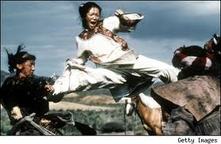
They're probably movies you'll never get to see, but these are a few of the potentially awesome movies that my students could dream up using our vocabulary concepts!
For current movies with insultingly stupid physics, check out this website
http://www.intuitor.com/moviephysics/
For current movies with insultingly stupid physics, check out this website
http://www.intuitor.com/moviephysics/
Force: A Racing Movie
|
Rovzilla Movie
|
Comic Strip Physics
_In this project students worked as a group to create a comic strip.
First they designed their story line and then each person was in charge
of illustrating, describing, and graphing what was happening in the
their portion of the comic strip. Look at some of the examples.
|
|
Flip Book Science - Stellar Evolution and Chemical Bonding
Stars are the machines that use the forces of nature to build atoms in our universe. Check out these videos of stellar life cycles using online flip book apps. Students had to use a minimum of 30 frames for this animation. I'll be posting bonding flip books soon!
|
Atom Models

We studied substances this year and learned that all substances are made up of atoms. Here are some of the pictures of the models we created. The video is one of the models too!
|
|
Planetary/Substance Project
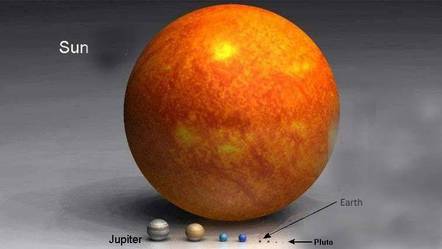
In this project students had to use their knowledge of substances (pure and mixtures, alloys, solutions, etc.) and to research a planet. They then had to find what and where substances were found on their planets.
The websites found to the right are some of the many student examples that were constructed in lieu of building a model, etc. |
|
Mystery Powder Lab - Identifying a Chemical Reaction
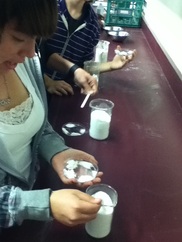
For this lab the students collected 5 unknown powders. Then each student in the group was in charge of testing these powders with various fluids or with heat. They looked for signs of chemical change and shared their results. Quite a popular lab to say the least. What happened? You'll have to view the pictures to the left to get a clue. No fair giving away secrets!
|
| ||||||||
pHear pHactor Lab
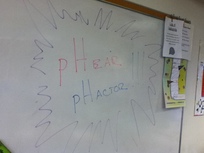
In this lab three brave students went head to head to try and identify up to 18 different solutions! Blind folded and only armed with their tongues, the following pictures will give you a sense of the sweetness of victory and the bitterness of defeat. Meanwhile, the rest of the class recorded the pH of the solutions and then color coded the data in red, blue, or green. Last, we looked for trends in the data we collected. One example of these trends was that many of the edible solutions were in the red range (and acid). The next day we followed up by testing the household solutions that the students brought in and we started to see the trends in edible vs. non-edible solutions and what pH means to our lives.
|
|
Here's how to do it.
|
Here are examples.
|
Final Project
After a year of learning about chemistry, force and motion, density, and how science works in general, each student needs to work by themselves of in a group of no more than three students to solve a real world problem. Look to the right for their solutions.
|
How do we get fresh water to people who live on islands surround by ocean? Click here to find out how we can save the people of Wiki-Wiki.
Check out this website to hear the about one group's conclusion about what to do in Awesomeville! Click Here.
This site is all about the practicality of high speed Mag-Lev trains. Click Here.
Here's a website that looks at one solution to StarShock Coffee's questions of which cup is best for the environment. Click Here.
|
|
